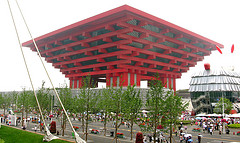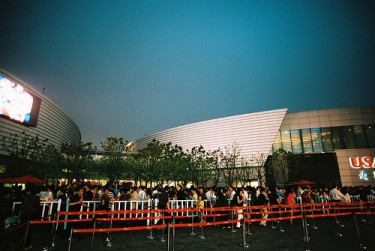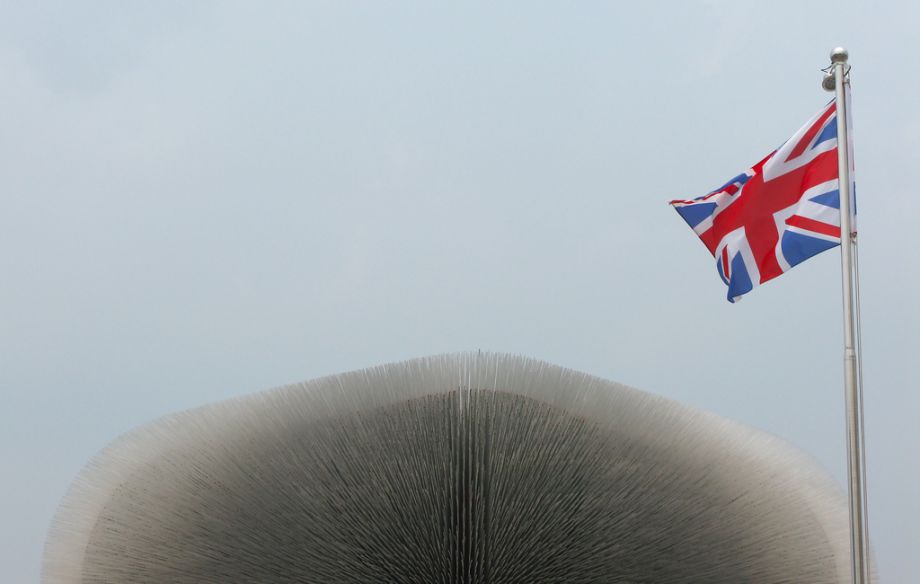For all my aforementioned misgivings about the Expo, it’s impossible to deny the spectacular immensity of it. It’s also impossible to deny the tremendous Expo enthusiasm. Throngs of people run—often in full gallop—between the most popular pavilions. They wait in line for four, five, six hours or more, especially for the more garish and eye catching exhibits. I even witnessed one person try to crash the gate at the Italian pavilion before security closed in. I wrote my last dispatch on what’s inside some of these pavilions, but it’s the exteriors of these constructions that make the Expo astonishing to look at. This is ground zero for architectural somersaults.
To start with, the Expo itself has all the elaborate public infrastructure of a mid-sized city. This includes its own internal subway line. There are also two gigantic pedestrian skywalks that serve as elevated, and very broad, boulevards, and would be an impressive sight in any world capital. A stroll on these offers the best perspectives of the Expo grounds, which are simply too vast and sprawling to comprehend from the street level.  The larger skywalk on the Pudong side of the grounds inevitably leads to the massive China Pavilion (pictured at left, image by Lee Blake Somerset via Flickr). It’s a pagoda-style inverted pyramid that towers over everything else here. I have nothing to report first-hand about what’s inside, because it’s simply futile to try to walk in on an average day and waiting in line could eat up an entire visit. Signs try to alleviate popular frustration by reminding visitors that, unlike most everything else here, the China pavilion will remain after the Expo. In any case, it will be a worthy fixture in the already impressive Shanghai skyline. It is however interesting that this Expo will not leave any object piercing the sky like a Seattle Space Needle or an Eiffel Tower, given that this is one of the world’s preeminent vertical cities.
The larger skywalk on the Pudong side of the grounds inevitably leads to the massive China Pavilion (pictured at left, image by Lee Blake Somerset via Flickr). It’s a pagoda-style inverted pyramid that towers over everything else here. I have nothing to report first-hand about what’s inside, because it’s simply futile to try to walk in on an average day and waiting in line could eat up an entire visit. Signs try to alleviate popular frustration by reminding visitors that, unlike most everything else here, the China pavilion will remain after the Expo. In any case, it will be a worthy fixture in the already impressive Shanghai skyline. It is however interesting that this Expo will not leave any object piercing the sky like a Seattle Space Needle or an Eiffel Tower, given that this is one of the world’s preeminent vertical cities.
It’s the eye catching British pavilion that has generated the most discussion. The cubical structure’s protruding rods have provoked some to refer to it as a giant porcupine. The inside however has been
derided as sparse, and as a total disappointment for those who waited hours on end to get in. This criticism is unfair. The British pavilion, in my view, actually distinguishes itself by not going for a seizure inducing sensory overload. Inside there are no gift shops, no attempts to wow us with dramatic sound effects or flashing lights, and best of all no self-serving government or corporate promo videos. Instead the pavilion beckons you to study the details. Embedded in each rod, on the inside, is a different seed from a plant endemic to Britain—a unique play on the Expo’s ubiquitous “green” theme. The
only pavilion to top this in wackiness is the Hungarian pavilion, which touts a supposedly new geometric shape discovered by Hungarians. The pavilion’s neon glowing interior guides you through a forest of hanging ply wood toward a giant metallic rock that is supposedly the foundation of all geometric shapes, and serenity itself (their claims, not mine).
The post-modern minimalism of these two pavilions, however bizarre, looks downright brilliant compared to the dismal US pavilion (at right, image by Eugene Regis via Flickr).  Enough has already been said about it—some likened it to a suburban movie theatre, others say back-lot government building. The best superlative that Hillary Clinton could muster was that it was “fine.” I only bring this up to add that it makes for a missed diplomatic opportunity. Other countries leaped at the chance to present their own unblemished self-images to tens of millions of Chinese visitors, and the US just looks disinterested. I’m of two minds on this, and sympathetic to those who call pavilion construction a waste. But give credit to the numerous other participants who at least did it well (and for far cheaper). I can only think to contrast US blandness with the following ideas: The Danish pavilion is a downward spiral track on which people can bike, another take on the “green” theme. The Netherlands has a network of catwalks cut out to look like Amsterdam that offers terrific vistas of the rest of the Expo. The French pavilion performs weddings.
Enough has already been said about it—some likened it to a suburban movie theatre, others say back-lot government building. The best superlative that Hillary Clinton could muster was that it was “fine.” I only bring this up to add that it makes for a missed diplomatic opportunity. Other countries leaped at the chance to present their own unblemished self-images to tens of millions of Chinese visitors, and the US just looks disinterested. I’m of two minds on this, and sympathetic to those who call pavilion construction a waste. But give credit to the numerous other participants who at least did it well (and for far cheaper). I can only think to contrast US blandness with the following ideas: The Danish pavilion is a downward spiral track on which people can bike, another take on the “green” theme. The Netherlands has a network of catwalks cut out to look like Amsterdam that offers terrific vistas of the rest of the Expo. The French pavilion performs weddings.
Much of the country pavilions are set to be destroyed after the event ends. This woefully contradicts the Expo’s green message. It means yet another round of carbon coughing construction once these grounds are redeveloped. That said, few of these pavilions have any practical uses beyond the Expo. Keeping and maintaining them would be a terrible idea (and against BIE regulations). From China’s perspective, most pavilion construction was paid for by participants anyway. The things China and Shanghai invested in were more lasting—including new subway lines, a beautiful new park, and tons of redeveloped land on which to build. This is far sighted policy in comparison to the huge Olympic venues that Shanghai’s rival city Beijing is now stuck with.
To read Josh’s other dispatches from Shanghai, click here.












